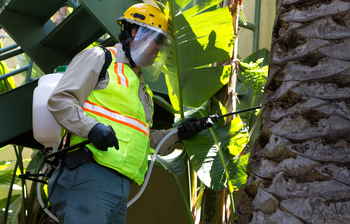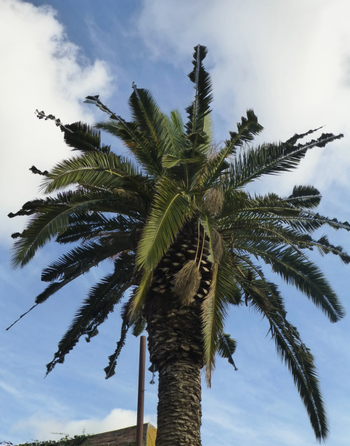Management Options
If SAPW is found on your property, you have several management options. The spread of this pest can be delayed with the fast detection and removal of infested trees. Chipping, burning, and burying infested material deeply can reduce the likelihood that SAPW will emerge and escape from infested palms. Keeping the palms healthy, the reduction of pruning activity, and the use of systematic insecticide application may prevent infestations of the SAPW. However, research is still ongoing for the most effective control method. The following management options are provided based on current SAPW research findings.
Determine Treatment Factors for a Specific Site or Tree

Development of a treatment program that incorporates the use of pesticides should include the advice of a professional arborist. Property owners should hire a professional pest control advisor or arborist who has experience treating SAPW and other infestations in large palms or trees.
If a palm is badly infested and is declining or dead, removal is a good option. Always chip or bury (within 24 hours) infested tree material. Improper disposal of infested material can contribute to SAPW spread. Because SAPW only attacks the crowns of host palms, it is not necessary to remove the whole palm trunk.
Treat Infested Palms Immediately
Crown spraying along with a soil systemic has been shown to be the most effective control of SAPW.
Crown Spraying
Crown spraying is an insecticide treatment applied to the center meristem area, targeting active adults to disrupt their life-cycle. Bifenthrin, imidacloprid, and/or dinotefuran are the active chemicals used in this method.
FACTORS TO CONSIDER:
- Public areas, parks, HOA, Riparian/overgrown areas may require special permissions.
- Cannot be applied in weather such as rain, wind, or heat.
- In very tall palms it will be difficult to properly drench the crown.
Root & Soil Drench
Systemic insecticides are applied to the immediate root zone of the palm tree. The insecticide will trans-locate upward with new frond growth, helping to protect against new feeding. A mixture of imidacloprid (75%), Dinotefuran (20%) are used as the active chemical agents.
FACTORS TO CONSIDER:
- Translocation to the crown can take 60 days or more to complete.
- Soil conditions such as lack of water, runoff, or slope can make proper uptake difficult.
When treatment is no longer an option for an infested palm tree, quick removal is imperative to stopping the spread of SAPW to other trees.
Trunk & Basal Spray
A systemic insecticide is applied to the outer bark and root flare of the palm. A mixture of Dinotefuran (205) and Pentra Bark are the active chemical agents.
FACTORS TO CONSIDER:
- Faster uptake than other treatment methods.
- Does not last as long as other treatments (2-3 months).

Before South American Palm Weevil Strikes
With more than a million acres of susceptible palms in Southern California and millions more acres throughout the state, communities are encouraged to work collectively to develop prevention, monitoring, and response plans before SAPW strikes. The following outlines steps to take to prevent SAPW from getting out of control in your palms.

Monitor palm trees on your property for SAPW activity. Early SAPW detection greatly improves the chances of saving trees. Signs and symptoms of SAPW attack include:
- Accumulated frass (insect excrement) at frond bases.
- Pupal cases on the ground near the tree.
- Holes and tunneling at the base of the palm fronds and sheaths.
- Characteristic putrid odor.
- Progressive foliage yellowing and eventual death.
- Yellowing begins in the topmost, newest leaves and progressively goes down into the crown.
Preventative Protection
Protect susceptible palms with a systemic insecticide applied to either the trunk, crown, or soil.
3-4 treatments a year will be needed
Photo Source: Mark Hoddle, University of California, Riverside
